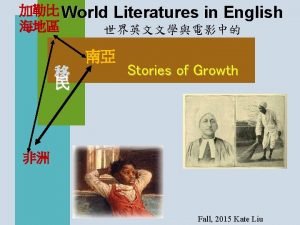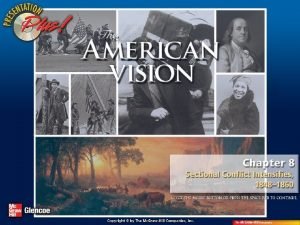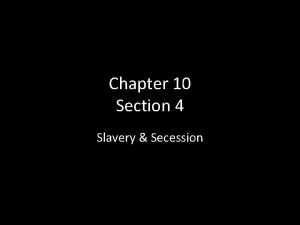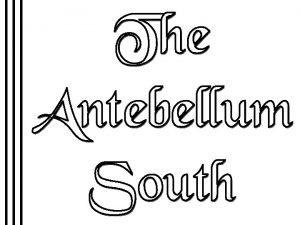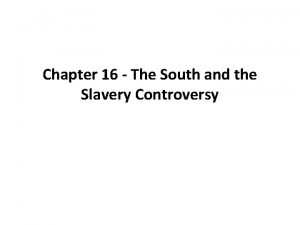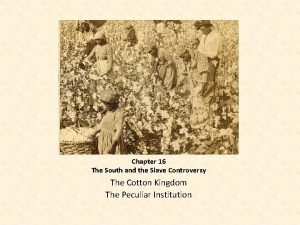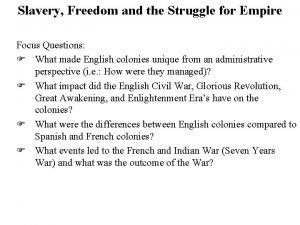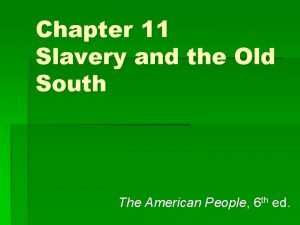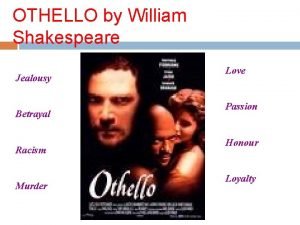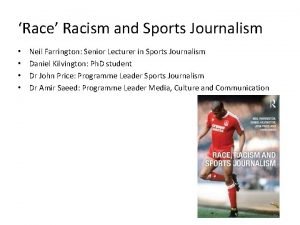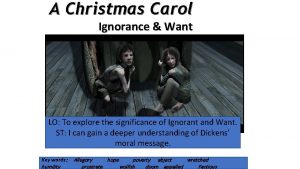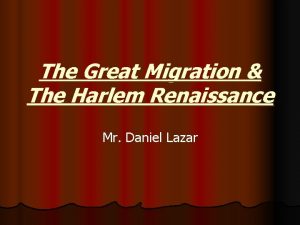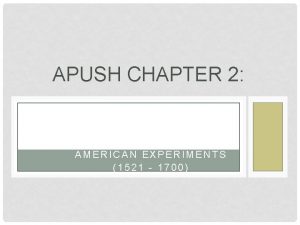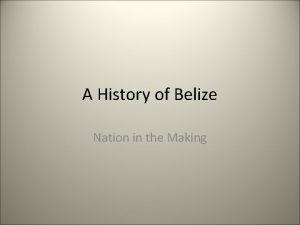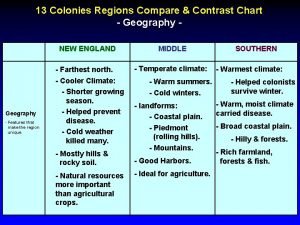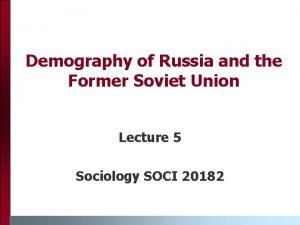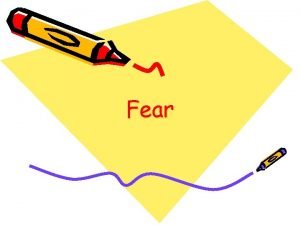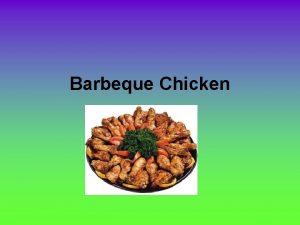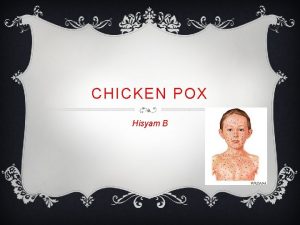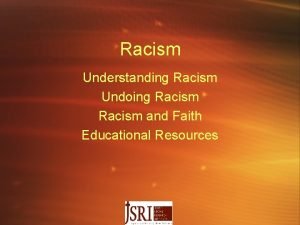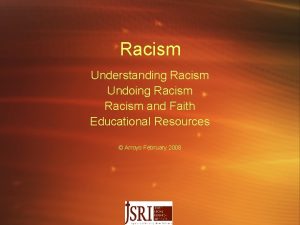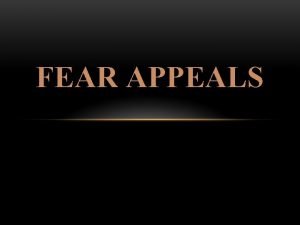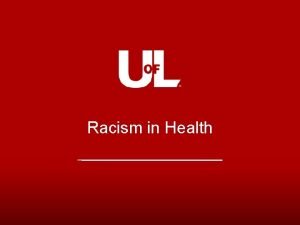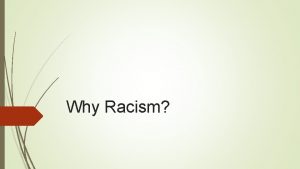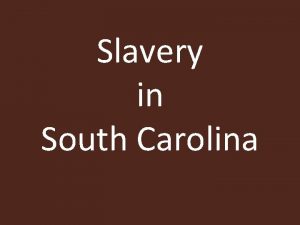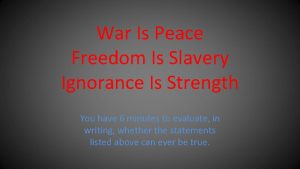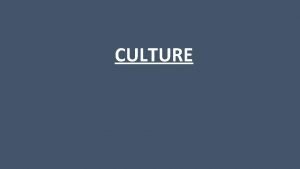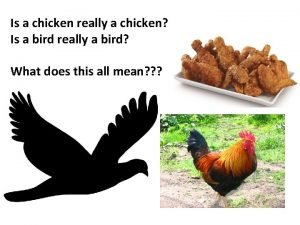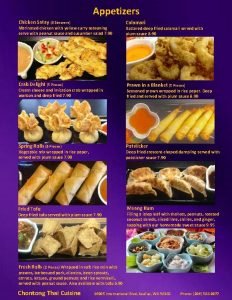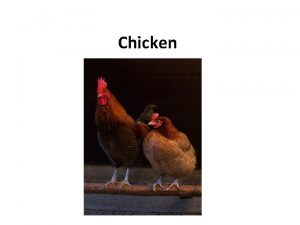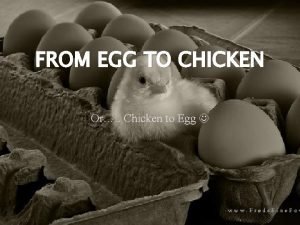Racism Fear Ignorance Slavery and Racism The Chicken




















- Slides: 20

Racism = Fear + Ignorance Slavery and Racism The Chicken and the Egg

Few human practices have provoked such deep and widespread outrage as the practice of one human being enslaving another. So why has slavery survived for thousands of years? How did it become so important to civilization? Explore the ways that slavery has been woven into the fabric of societies in America and around the world.

The institution of slavery is as old as civilization. Many nations and empires were built by the muscles of slaves. But what kinds of people were enslaved, and why? In ancient civilizations, slaves were usually war captives. The victors in battle might enslave the losers rather than killing them. Over time, people have found other reasons to justify slavery. Slaves were usually considered somehow different than their owners. They might belong to a different race, religion, nationality, or ethnic background. By focusing on such differences, slave owners felt they could deny basic human rights to their slaves. Who was enslaved? What rights did slaves have? How could slaves gain their freedom? The answers are different for every society with slaves. Click on any of the highlighted areas of the map to explore a few of the many slavebased societies in history. http: //school. discoveryeducation. com/s chooladventures/slavery/world. html

Olaudah Equiano was born into a wealthy West African family in 1745. His family was Ibo. They lived far from the sea, in an area now part of Nigeria. Olaudah Equiano's father was a village chief. He had seven children and many slaves, so Equiano grew up in a slave society. But it was a different kind of slavery, as Equiano noted in his autobiography: “With us the slaves do no more work than other members of the community, than even their master; their food, clothing and lodging were nearly the same as ours, except that they were not permitted to eat with those who were free-born; and there was scarcely any other difference between them than a superior degree of importance, which the head of a family possesses. ” Life of a Slave

Capture and Sale When he was eleven, Equiano was captured by African slave traders: One day, when all our people were gone out to their works as usual, and only I and my dear sister were left to mind the house, two men and a woman got over our walls, and in a moment seized us both, and, without giving us time to cry out, or make resistance, they stopped our mouths, and ran off with us into the nearest wood. Here they tied our hands, and continued to carry us. The slave traders separated Equiano from his sister and sold him several times, from one African master to another. Equiano's first owner treated him well. But he was determined to escape. "I was strengthened by the mortifying circumstance of not daring to eat with the free-born children. "

Sale to European Slavers Eventually he found himself on the Africa's Atlantic coast for the first time in his life. There he saw a slave ship anchored offshore. But he had no idea what lay ahead. No Africans had ever returned from the Americas to tell of their fate. When I looked around the ship and saw a large furnace of copper boiling, and a multitude of black people, of every description, chained together, every one of their countenances expressing dejection and sorrow, I no longer doubted of my fate; and, quite overpowered with horror and anguish, I fell motionless on the deck, and fainted. I asked if we were not to be eaten by those white men with horrible looks, red faces and long hair? "

How was slavery different in Africa and Europe and why? n With a partner discuss this and come up with a formal answer. Use Examples. How did this difference contribute to the slave trade overall? n With a partner discuss this and come up with a formal answer. Use Examples.

Passage on a Slave Ship The journey from Africa to America was called "The Middle Passage. " It was the middle leg of the triangular slave trade which began and ended in Europe. No African expected the misery and horror it held. Slavers packed three or four hundred Africans into a lower deck— the ship's cargo. The cargo hold was tiny— a person couldn't even stand up in it. The air in the hold was hot and stale. The smell of sweaty bodies and human waste made the air even more unpleasant. The stench of the hold while we were on the coast was so intolerably loathsome, that it was dangerous to remain there for any time, and some of us had been permitted to stay on the deck for the fresh air; but now that the whole ship's cargo were confined together, it became absolutely pestilential. The closeness of the place, and the heat of the climate, added to the number in the ship, which was so crowded that each had scarcely room to turn himself, almost suffocated us. This produced copious perspirations, so that the air soon became unfit for respiration, from a variety of loathsome smells, and brought on a sickness among the slaves, of which many died. The shrieks of the women, and the groans of the dying, rendered the whole a scene of horror almost inconceivable.

Slavery in America Disease and death were common. Up to 25 percent of a slave ship's Africans died during the voyage. The captain and crew struggled to keep their valuable cargo alive. They forced the Africans to dance on deck for exercise. Sometimes they force-fed Africans who would rather die than suffer further. The slave ship carrying Olaudah Equiano and hundreds of other Africans finally reached port. Their destination was the English colony of Barbados. Soon they were put up for sale. No one purchased Equiano, who was still just a boy of 12. So he was shipped north to a plantation in Virginia. There he was shocked to see the instruments used to control and punishment slaves: A black woman slave was cruelly loaded with various kinds of iron machines; she had one on her head which locked her mouth so fast that she could barely speak, and could not eat or drink.

Struggle for Freedom n n n Equiano was soon sold again. His new owner was a lieutenant in the British navy named Michael Henry Pascal gave him a new name: Gustavus Vassa. Equiano refused to answer to this name at first. Pascal slapped him with each refusal, and soon he relented. Under Pascal, Equiano learned to be a sailor. He spent much time in England, where managed to educate himself as well. He even fought for Britain in the Seven Years' War. I began to consider myself as happily situated, for my master treated me always extremely well; and my attachment and gratitude to him were very great. I soon grew a stranger to terror of every kind, and was, in that respect at least almost an Englishman. Equiano refused to give up. He began trading glasses and other objects on the side. Eventually he saved 40 pounds (equal to about $3, 700 today). That was enough to purchase his freedom. Before night, I who had been a slave in the morning, trembling at the will of another, was become my own master and completely free. I thought this was the happiest day I had ever experienced.

What does the sale and trade of slaves and their ability to buy their freedom say about the value of people in the 1500’s compared to today? With a partner discuss this and come up with a formal answer. Use Examples.

From Slavery to Racism As a freeman, Equiano continued working as a sailor for years. He traveled widely, but his personal struggle against racism and slavery continued. One day, a ship's captain decided to sell Equiano: I simply asked him what right he had to sell me? But, without another word, he made some of his people tie ropes round each of my ankles, and also to each wrist, and another rope around my body, and hoisted me up. Thus I hung, without any crime committed, and without judge or jury; merely because I was a free man, and could not by the law get any redress from a white person in those parts of the world. I was in great pain from my situation, and cried and begged very hard for some mercy, but all in vain. Not one white man on board said a word on my behalf. Equiano hung from the mast all night long. In the morning, he begged to be released. Since his body was blocking the sails, the crew brought him down. The ship's carpenter persuaded the captain to put Equiano ashore.

Ku Klux Klan n n At the end of the American Civil War radical members of Congress attempted to destroy the white power structure of the Rebel states. The Freeman's Bureau was established by Congress on 3 rd March, 1865. The bureau was designed to protect the interests of former slaves. This included helping them to find new employment and to improve educational and health facilities. In the year that followed the bureau spent $17, 000 establishing 4, 000 schools, 100 hospitals and providing homes and food former slaves. At first the main objective of white supremacy organizations such as the Ku Klux Klan, the White Brotherhood, the Men of Justice, the Constitutional Union Guards and the Knights of the White Camelia was to stop black people from voting. After white governments had been established in the South the Ku Klux Klan continued to undermine the power of blacks. Successful black businessmen were attacked any attempt to form black protection groups such as trade unions was quickly dealt with.

The Damage of Racism n n Duncan was 12 years of age when freedom was declared and remembers the hectic times which followed. He and other slave children attended schools provided by the Freedmen’Aid and other social organizations fostered by Northerners. Most of the instructors were whites sent to the South for that purpose. . All of the children secured enough learning to enable them to read and write, which was regarded as very unusual in those days. Slaves had been taught that their brain was inferior to the whites who owned them and for this reason, many parents refused to send their children to school, thinking it a waste of time and that too much learning might cause some injury to the brain of their supposedly weak-minded children.

Slavery Today Despite many efforts to end slavery, it still exists today. Some 27 million people worldwide are enslaved or work as forced laborers. That's more people than at any other point in the history of the world.

Child Slavery n n In India it was common for agents of manufacturers to go to rural areas and trick uneducated country folk. These people often had never been to a city, and knew nothing of city life. They lived very traditionally and were very poor. India is one of the poorest countries in the world. The agents would find poor people with a lot of children, and offer good jobs to one or more. Sometimes they would pay the parents an advance on salary, which would be pennies to us, but was valuable to people in India. Then, they would take the children away. They would make all sorts of promises to the parents that were never kept.

A 9 -year-old girl toils under the hot sun, making bricks from morning to night, seven days a week. She was trafficked with her entire family from Bihar, one of the poorest and most underdeveloped states in India, and sold to the owner of a brick-making factory. With no means of escape, and unable to speak the local language, the family is isolated and lives in terrible conditions. [photo by Kay Chernush for the U. S. State Department]

Street kids, runaways, or children living in poverty can fall under the control of traffickers who force them into begging rings. Children are sometimes intentionally disfigured to attract more money from passersby. Victims of organized begging rings are often beaten or injured if they don't bring in enough money. They are also vulnerable to sexual abuse. [photo by Kay Chernush for the U. S. State Department]

This woman in her early 20 s was trafficked into a blue jean sweatshop, where she and other young women were locked in and made to work 20 hours a day, sleeping on the floor, with little to eat and no pay. She managed to escape and was brought to the government-run Baan Kredtrakarn shelter in Bangkok. After a few days, when she felt safe enough to tell her story to the director, the police were informed and they raided the sweatshop, freeing 38 girls, ages 14 -26. [photo by Kay Chernush for the U. S. State Department]

Why does slavery still exist and what does it say about humanity both now and in the past? With a partner discuss this and come up with a formal answer. Use Examples.
 What is coloniazation
What is coloniazation Modifiers of human acts ignorance examples
Modifiers of human acts ignorance examples Lesson 1 slavery and western expansion
Lesson 1 slavery and western expansion Chapter 10 section 4 slavery and secession
Chapter 10 section 4 slavery and secession Key and peele slavery
Key and peele slavery Chapter 16 the south and the slavery controversy
Chapter 16 the south and the slavery controversy Chapter 16 the south and the slavery controversy
Chapter 16 the south and the slavery controversy Slavery freedom and the struggle for empire
Slavery freedom and the struggle for empire Chapter 11 cotton slavery and the old south
Chapter 11 cotton slavery and the old south Chapter 11 cotton slavery and the old south
Chapter 11 cotton slavery and the old south Shakespeare's tragedy about racism and jealousy
Shakespeare's tragedy about racism and jealousy Jealousy theme statement
Jealousy theme statement Race racism and sports journalism
Race racism and sports journalism A christmas carol ignorance and want
A christmas carol ignorance and want Chapter 16 lesson 2 challenges to slavery
Chapter 16 lesson 2 challenges to slavery Palmer hayden jeunesse
Palmer hayden jeunesse Chapter 2 american experiments
Chapter 2 american experiments When was slavery abolished in belize
When was slavery abolished in belize Comparing and contrasting the thirteen colonies
Comparing and contrasting the thirteen colonies Charter colonies definition
Charter colonies definition Net reproduction rate
Net reproduction rate
